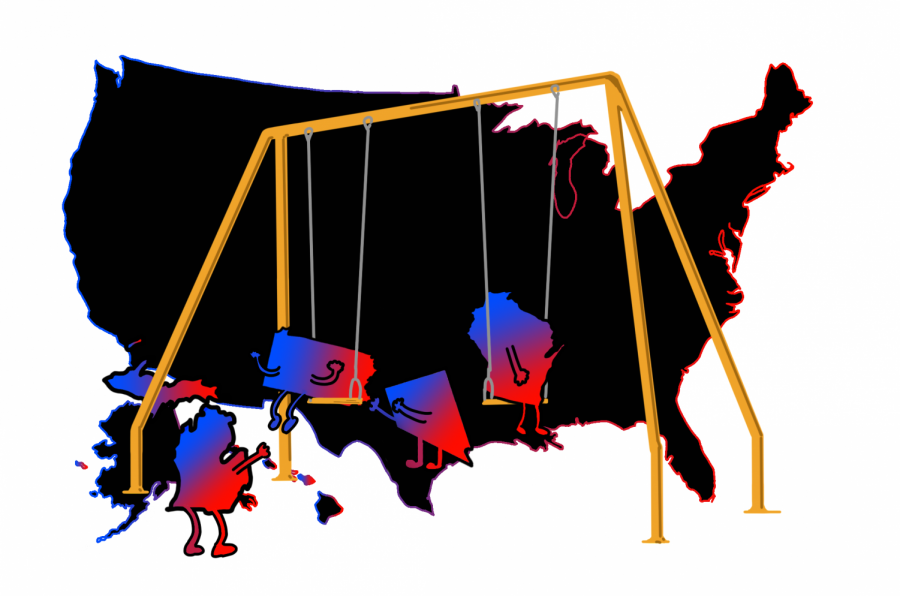The battleground states
November 18, 2020
After a long, seemingly never ending stretch, America has finally voted on a new president. Joe Biden took the lead at the end of the race, securing Michigan, Wisconsin, Pennsylvania, and Nevada, sending his score over the 270 edge. However, the race was nowhere near easy, and many Americans found themselves glued to their television screens for the week-long period.
The presidential election of 2020 was different from previous years for multiple reasons. Many people decided to vote by mail instead of voting in person in order to stay safe from the Coronavirus. This caused the results to be delayed, which is why the winner was called four days after election night. This delay was primarily because multiple states did not count the mail in votes until after the election, causing a large surge of blue votes. By the end of the election, these votes were the main reason why multiple states turned blue. Before the election, Biden advised his supporters to vote by mail while President Donald Trump claimed that voting in person was the most secure way for them to vote. Ultimately, despite many Trump supporter’s beliefs, the end result of the 2020 election was due to the overwhelming surge of blue mail in votes in battleground states, not because of fraud like many claimed.
2020 was also a turning-point year because of the self-proclaimed “battleground states.” 2020 marked a year in which many states flipped their colors and were the primary reason for the end result of the election. For example, Arizona, a previously Republican state, flipped to the Democratic side this year. The state had not been called Democratic since the election of Bill Clinton in 1996, where Clinton took the state from Republican Bob Dole. The predicted reason for the state turning blue is because of how President Trump dealt with the Coronavirus, seeing as 1 in 5 residents of Arizona are over the age of 65, according to CBS News.
Another “battleground”, or flip-state, was Iowa. During the 2008 and 2012 elections, Iowa voted for former President Barack Obama, causing the state to go blue. However, the state ended up calling it as a win for President Trump because, as CBS News states, “Mr. Trump still has a large advantage among voters without a college degree and White evangelicals.” In the end, Joe Biden and Kamala Harris ended up taking the victory because of three main states: Pennsylvania, Michigan, and Wisconsin. These states took Biden’s small advantage on Trump to an enormous victory.
Wisconsin has a similar Republican voter-turnout to Arizona, of primarily white men. For many elections leading up to 2020, Wisconsin had turned blue and acted as a vote for the Democratic candidate. This changed in 2016, though, when the state ended up supporting Trump instead of Hilary Clinton, the Democratic candidate. This left 2020 voters in suspense of what could happen. In the end, though, the state acted as yet another win for Biden, helping him take the lead.
Michigan was in a very similar situation. The state had cast its electoral votes towards the Democratic candidates for many years, and then ended up switching for the Republicans in the 2016 election. Trump’s three percent lead on Hilary Clinton in 2016 gave him the upperhand, and resulted in him winning the election. Nevertheless, Michigan voters changed their opinions this year and gave Biden more votes, causing him to be 6 electoral votes away from victory.
Pennsylvania switched from red to blue last minute, causing many Americans to be on the edge of their seats. The state was projected to go red during the election, and after a few days, this seemed very likely. Most of Pennsylvania remained red, and still remains red, but because of the large cities inside of the state like Pittsburgh and Philadelphia, the Democrats reigned supreme and took over. This allowed Joe Biden to have a .6% lead on President Trump, winning him the state.
When the election was finally over, Trump repeatedly told the American people that fraud had occurred because of the large increase of blue votes. He insisted that a recount was necessary because many states had a narrow margin between red and blue. In fact, he has filed over twenty lawsuits, all claiming that the election was unfair and unconstitutional. At this point in time, all of them except for one have been dismissed, along with many lawyers withdrawing their claims.
President Trump was the first president since George H. W. Bush to not be elected for a second term. Why is that? Something to consider is how the two candidates reacted when the race was being finalized and the results were finally beginning to show. Although the two men were neck and neck for multiple days, Donald Trump reacted harshly to the idea that his position could be taken from him. Trump tweeted constantly that the election was corrupt and a recount was necessary. This behavior contrasted with Biden’s calm and collected tone, telling his supporters to not worry because a win was on the way.
In the end, this calm attitude worked for Joe Biden because he ended up winning the 2020 election, becoming the 46th president. 2020 is a year that will make history books for sure, mainly because of how suspenseful the election turned out to be. Americans can finally rest, though, and will no longer have to worry about the fate of the presidency. Who knows what will happen in 2024. Everything is up in the air, and maybe that’s the way it’s supposed to be.



